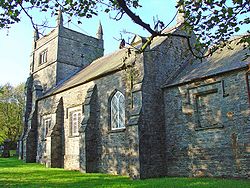
Llanfyrnach
Encyclopedia

Pembrokeshire
Pembrokeshire is a county in the south west of Wales. It borders Carmarthenshire to the east and Ceredigion to the north east. The county town is Haverfordwest where Pembrokeshire County Council is headquartered....
, Wales
Wales
Wales is a country that is part of the United Kingdom and the island of Great Britain, bordered by England to its east and the Atlantic Ocean and Irish Sea to its west. It has a population of three million, and a total area of 20,779 km²...
. The name means "church of St Brynach
Brynach
Saint Brynach was a 6th century Welsh saint. He is traditionally associated with Pembrokeshire, where several churches are dedicated to him.A 12th century 'life' tells us that some time in the early 6th century, Brynach travelled to Rome and Brittany, and then on to Milford Haven...
". It is situated in a remote upland area on the headwaters of the River Tâf
River Tâf
The River Tâf is a river that rises in the Preseli Hills of North Pembrokeshire, West Wales, near the village of Crymych and is around 50 km long....
, about 18 km from Cardigan
Cardigan, Ceredigion
Cardigan is a town in the county of Ceredigion in Mid Wales. It lies on the estuary of the River Teifi at the point where Ceredigion meets Pembrokeshire. It was the county town of the pre-1974 county of Cardiganshire. It is the second largest town in Ceredigion. The town's population was 4,203...
, the nearest town. The parish is included within the community
Community (Wales)
A community is a division of land in Wales that forms the lowest-tier of local government in Wales. Welsh communities are analogous to civil parishes in England....
and ward of Crymych
Crymych
Crymych is a small village of around 400 inhabitants in the north of Pembrokeshire, Wales. The village developed around the former Crymmych Arms railway station on the now closed line, nicknamed the Cardi Bach , which ran from Whitland to Cardigan.Other than the Crymych Arms public house, which...
.
There is a small Norman
Norman architecture
About|Romanesque architecture, primarily English|other buildings in Normandy|Architecture of Normandy.File:Durham Cathedral. Nave by James Valentine c.1890.jpg|thumb|200px|The nave of Durham Cathedral demonstrates the characteristic round arched style, though use of shallow pointed arches above the...
motte
Motte-and-bailey
A motte-and-bailey is a form of castle, with a wooden or stone keep situated on a raised earthwork called a motte, accompanied by an enclosed courtyard, or bailey, surrounded by a protective ditch and palisade...
close to the church. Much of the parish was unenclosed moorland until the start of the nineteenth century. Population doubled as numerous small farms were established following enclosure
Enclosure
Enclosure or inclosure is the process which ends traditional rights such as mowing meadows for hay, or grazing livestock on common land. Once enclosed, these uses of the land become restricted to the owner, and it ceases to be common land. In England and Wales the term is also used for the...
. The Whitland & Taf Vale Railway reached the village in 1873, and the village became a transport depot for the surrounding hill country, a role that it still retains although the railway closed in 1963. Lead and agricultural produce were shipped out, and heavy supplies, notably lime
Calcium oxide
Calcium oxide , commonly known as quicklime or burnt lime, is a widely used chemical compound. It is a white, caustic, alkaline crystalline solid at room temperature....
, were brought in. The village remains small, with much of the workforce employed in transportation. The area remains staunchly Welsh
Welsh language
Welsh is a member of the Brythonic branch of the Celtic languages spoken natively in Wales, by some along the Welsh border in England, and in Y Wladfa...
-speaking.
There was an important lead
Lead
Lead is a main-group element in the carbon group with the symbol Pb and atomic number 82. Lead is a soft, malleable poor metal. It is also counted as one of the heavy metals. Metallic lead has a bluish-white color after being freshly cut, but it soon tarnishes to a dull grayish color when exposed...
mine on the north side of the village until the end of the nineteenth century. Mining occurred on a small scale for the sake of the low but significant concentration of silver
Silver
Silver is a metallic chemical element with the chemical symbol Ag and atomic number 47. A soft, white, lustrous transition metal, it has the highest electrical conductivity of any element and the highest thermal conductivity of any metal...
in the ores, perhaps from as early as the sixteenth century. As a result of high demand for lead in the Victorian era
Victorian era
The Victorian era of British history was the period of Queen Victoria's reign from 20 June 1837 until her death on 22 January 1901. It was a long period of peace, prosperity, refined sensibilities and national self-confidence...
, the mine was greatly extended in the 1840s, and had reached 520 m below the surface by the time of its closure in 1890.
Population of the parish: 542 (1801): 933 (1851): 954 (1901): 844 (1951): 837 (1981). Percentage Welsh speakers 100 (1891): 97 (1931): 82 (1971).
The Welsh language poet Thomas Evan Nicholas (Niclas y Glais)
Thomas Evan Nicholas (Niclas y Glais)
Thomas Evan Nicholas ,was a Welsh language poet, preacher, radical, and champion of the disadvantaged of society....
was born in Llanfyrnach yn 1878.

